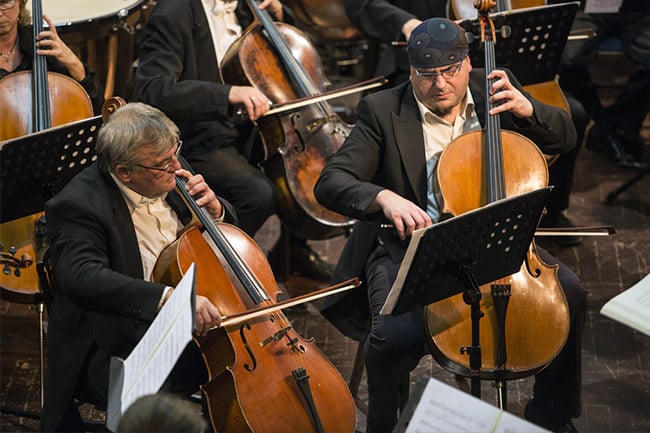
2020年10月11日 19:00
聖母マリア昇天バジリカ教会、スタレー・ブルノ
ブルノ国民劇場・ヤナーチェク・オペラ、オーケストラと合唱団
指揮―オンドレイ・オロス
合唱団団長―パヴェル・コニャーレク
ソリスト:ペテル・ベルゲル、ヤナ・フロホヴァー、イジー・スルジェンコ、パヴラ・ヴィコパロヴァー
Note: Visitors sit with their backs to the orchestra, choir and soloists.
レオシュ・ヤナーチェク(1854-1924):永遠の福音 JW III/8、ヤロスラフ・ヴルフリツキー詩、ソロ、混声合唱、オーケストラのためのレジェンド
グラゴール・ミサ JW III/9、ソロ、混声合唱、パイプオルガンとオーケストラのための作品
Leoš Janáček (1854–1924): The Eternal Gospel, JW III/ 8, a legend for soloists, mixed choir and orchestra based on a poem by Jaroslav Vrchlický
The Glagolitic Mass, JW III/9, for soloists, mixed choir, organ and orchestra
The gallery of the Basilica of the Assumption of the Virgin Mary in Old Brno was a very significant place for Janáček. He was raised in the Augustinian abbey from the age of 11, sang as a choral scholar in the Old Brno basilica gallery, and subsequently also played the organ there. After Pavel Křížkovský left for Olomouc, Janáček became the director of the choir in 1872.
The legend in verses with the title The Eternal Gospel – Legend 1240 from the collection Frescoes and Tapestries published in 1891 is inspired by the teachings of the medieval monk Joachim of Fiore (1132-1202), whose interpretation of history culminates in the period of Holy Spirit, or in other words the love of all mankind for all of creation. It is somewhat symbolic that Janáček set this message to music shortly before the outbreak of World War I. We do not know exactly when the composition was made, but the first document confirming the existence of the completed piece dates from 1914. In Janáček´s The Eternal Gospel, the prophecy of Joachim of Fiore is divided into four parts with an emphasis on the tenor part and the choir. The Gospel is closely connected musically with the opera The Excursions of Mr. Brouček, and not only as far as the instruments are concerned. The premiere took place on 5th February 1917 staged by the Prague singing association Hlahol and the Czech Philharmonic Orchestra led by the conductor Jaroslav Křička.
The Glagolitic Mass is undoubtedly one of the foremost spiritual compositions of the 20th, or indeed any century. Janáček gave some thought to the composition in 1920 but didn´t get round to commencing purposeful work on it until 1926, when he composed the piece during a rainy stay at the spa in Luhačovice. The use of the Church Slavonic language is not surprising in Janáček´s case because the monastery in Old Brno, where he spent the latter part of his childhood, was a centre of the cult of Cyril and Methodius. Janáček himself, as a choral scholar, took part in the grand Velehrad celebrations held to mark the occasion of the 1000th anniversary of Cyril´s death. The work was generously conceived for soloists, choir, orchestra and organ, and its premiere was performed by Beseda brněnská with the National Theatre orchestra on 5th December 1927 under the baton of Jaroslav Kvapil.
The Glagolitic Mass is one of the most oft-performed spiritual compositions of the 20th century, and it still amazes and enchants through its novelty, energy and tenderness. Even though Janáček dedicated this composition to a high dignitary of the Catholic church, the Archbishop of Olomouc Leopold Prečan, the spiritual dimension of the work goes beyond Catholic doctrine and aims somewhere towards Janáček-style pantheism.
Autor: Jiří Zahrádka
